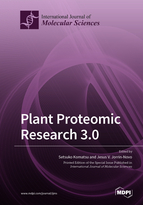Plant Proteomic Research 3.0
A special issue of International Journal of Molecular Sciences (ISSN 1422-0067). This special issue belongs to the section "Molecular Plant Sciences".
Deadline for manuscript submissions: closed (30 September 2020) | Viewed by 119790
Special Issue Editors
Interests: proteomics; omics; crop; abiotic stress; phosphorylation; signal transduction
Special Issues, Collections and Topics in MDPI journals
Interests: forest species; biotic and abiotic stresses; molecular markers; omics approaches; systems biology
Special Issues, Collections and Topics in MDPI journals
Special Issue Information
Dear Colleagues,
This Special Issue is the continuation of our 2016 Special Issue, "Plant Proteomic Research" (https://www.mdpi.com/journal/ijms/special_issues/plant-proteomic) and “Plant Proteomic Research 2.0” (https://www.mdpi.com/journal/ijms/special_issues/plant-proteomic_2)
Advancement in high-throughput “Omics” techniques has revolutionized plant molecular biology research. Proteomics offer one of the best options for the functional analysis of the genome, generating detailed information that integrated with that obtained by other classic and -omics approaches will provided a deeper knowledge of the different plant processes Up to six different generations of proteomics platforms (gel, label, gel free/label free, targeted) have appeared in the last twenty years which are being exploited in describing protein profiles, PTMs and interactions. Nevertheless, the ultimate success of any proteomic strategy lies in the various factors including isolation of full component of proteins, separation, visualization and their accurate identification. Despite recent advancements, more emphasis needs to be given to the protein extraction protocols, especially for very low-abundant, hydrophobic, and large molecular weight. Thus, amalgamation of diverse MS techniques, complemented with genome-sequence data and modern bioinformatics analysis with improved sample preparation and fractionation strategies, offer a powerful tool to identify and characterize novel proteins and to follow temporal changes in protein relative abundances under different environmental conditions. Furthermore, post-translational modifications and protein-protein interactions provide deeper insight into protein molecular function. Authors are welcome to submit original research articles and reviews addressing recent advancements, as well as limitations of current proteomic techniques and their diverse applications to get new insights of plant molecular responses to various biotic and abiotic stressors and the molecular bases of other processes. Proteomics focus is also related to translational purposes, including food traceability and allergen detection. In addition, bioinformatic techniques are needed for a more confident identification, quantitation, data analysis and networking, especially with non-model, orphan, plants, including medicinal, and meditational plants as well as forest tree species.
Prof. Dr. Setsuko Komatsu
Prof. Dr. Jesus V. Jorrin-Novo
Guest Editors
Manuscript Submission Information
Manuscripts should be submitted online at www.mdpi.com by registering and logging in to this website. Once you are registered, click here to go to the submission form. Manuscripts can be submitted until the deadline. All submissions that pass pre-check are peer-reviewed. Accepted papers will be published continuously in the journal (as soon as accepted) and will be listed together on the special issue website. Research articles, review articles as well as short communications are invited. For planned papers, a title and short abstract (about 100 words) can be sent to the Editorial Office for announcement on this website.
Submitted manuscripts should not have been published previously, nor be under consideration for publication elsewhere (except conference proceedings papers). All manuscripts are thoroughly refereed through a single-blind peer-review process. A guide for authors and other relevant information for submission of manuscripts is available on the Instructions for Authors page. International Journal of Molecular Sciences is an international peer-reviewed open access semimonthly journal published by MDPI.
Please visit the Instructions for Authors page before submitting a manuscript. There is an Article Processing Charge (APC) for publication in this open access journal. For details about the APC please see here. Submitted papers should be well formatted and use good English. Authors may use MDPI's English editing service prior to publication or during author revisions.
Keywords
- plant proteomic research
- methods, techniques and protocols of plant proteomics
- applications of plant proteomics
Benefits of Publishing in a Special Issue
- Ease of navigation: Grouping papers by topic helps scholars navigate broad scope journals more efficiently.
- Greater discoverability: Special Issues support the reach and impact of scientific research. Articles in Special Issues are more discoverable and cited more frequently.
- Expansion of research network: Special Issues facilitate connections among authors, fostering scientific collaborations.
- External promotion: Articles in Special Issues are often promoted through the journal's social media, increasing their visibility.
- Reprint: MDPI Books provides the opportunity to republish successful Special Issues in book format, both online and in print.
Further information on MDPI's Special Issue policies can be found here.








